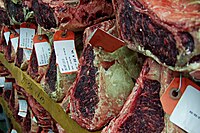
Photo from wikipedia
Beef was dry aged for 40-60 days under controlled environmental conditions in a refrigerated room with a relative humidity of 75%-80% and air-flow. To date, there is little information on… Click to show full abstract
Beef was dry aged for 40-60 days under controlled environmental conditions in a refrigerated room with a relative humidity of 75%-80% and air-flow. To date, there is little information on the microbial diversity and characteristics of dry aged beef. In this study, we explored the effect of change in meat microorganisms on dry aged beef. Initially, the total bacteria and LAB were significantly increased for 50 days during all dry aging periods. There was an absence of representative foodborne pathogens as well as coliforms. Interestingly, fungi including yeast and mold that possess specific features were observed during the dry aging period. The 5.8S rRNA sequencing results showed that potentially harmful yeasts/molds (Candida sp., Cladosporium sp., Rhodotorula sp.) were present at the initial point of dry aging and they disappeared with increasing dry aging time. Interestingly, Penicillium camemberti and Debaryomyces hansenii used for cheese manufacturing were observed with an increase in the dry aging period. Taken together, our results showed that the change in microorganisms exerts an influence on the quality and safety of dry aged beef, and our study identified that fungi may play an important role in the palatability and flavor development of dry aged beef.
Journal Title: Journal of microbiology and biotechnology
Year Published: 2018
Link to full text (if available)
Share on Social Media: Sign Up to like & get
recommendations!